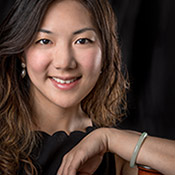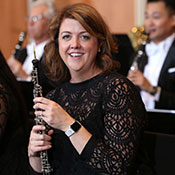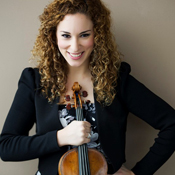
“Coming together and making something beautiful”: MSO Principals Prepare for Haydn’s Sinfonia Concertante
David Lewellen
PUBLISHED
Tagged Under: 2017.18 Season, Bassoon, Cello, Classics, MSO Musicians, Oboe, Violin
When Edo de Waart returns to conduct the Milwaukee Symphony this week, audiences will also get to appreciate his legacy as an orchestra builder.
The program will include Haydn’s Sinfonia Concertante, featuring four soloists from the orchestra, all of whom de Waart hired during his eight-year tenure as music director. “That’s one of his greatest skills as a conductor, to choose people who are incredible musicians,” said principal oboe Katherine Young Steele, one of the quartet of soloists. In addition, the performances feature principal bassoon Catherine Chen, principal cello Susan Babini, and associate concertmaster Ilana Setapen.
“It’s going to be amazing,” said Babini. “That’s an all-star group of people I’m playing with. I’m pretty excited.” She called the Haydn “a very fun piece but extremely tricky,” particularly when she has to play the same complicated figures as the violin and oboe but in a much lower register.
“It’s really exciting,” agreed Setapen, who was one of de Waart’s first appointments in 2009. She and Babini have played chamber music together before, and “Susan puts so much thought into how she prepares and performs everything. Everything has meaning and thought behind it.”
Symphony artistic leadership approached all four players early this year to ask if they’d be interested in the assignment, and all were enthusiastic. “Of course I said yes,” Steele said, “because I love Haydn of any sort, and I think Edo is excellent with it. And we don’t play it much in the orchestra.”
Chen joined the MSO in January, only weeks before the 2017.18 schedule was announced, and she was asked on her first day of work if she’d be willing to perform the Sinfonia Concertante. “I guess they were pretty confident in me,” she said. “I’m very happy to be here. Everyone is supportive and friendly; it’s a great band. I’m just sad Edo’s not here anymore, but I’ll be happy to see him [this] week.”
The foursome have been practicing the piece on their own for months, but this week they will play it together for the first time on Tuesday, before the orchestra rehearsal on Wednesday. “We’ll be working on a lot of little details,” Steele said. “Which note do we start the trill on, are we going to end the same way, are we going to articulate the same way?”
“We’ll wait for Ilana and Susan to work out bowings and take it from there,” Chen said. She already knew of the piece, because there isn’t much solo repertoire for bassoon, but in normal times, it is “at the back of the bookshelf.” Over the summer, while she was at the Marlboro Music Festival in Vermont, she got three colleagues plus a pianist to rehearse the piece with her, which gave her more insight into performance. “I love the colors that bassoon can make with violin and cello,” she said. “You never get to hear that kind of sound.”
Haydn is “so simple, but within the simplicity there’s incredibly exciting, expressive writing,” Steele said. “Especially for flute and oboe. Mozart saved those ideas for his operas, or for other instruments.”
Chen agreed, “It’s very virtuosic, singing, expressive, lyrical. There’s so much character you can get out of this music, and Haydn brings the characters out.”
Another notable feature of the concert, Steele said, is that “we think it’s pretty amazing that we have four women” as soloists — and they are far from the only women in leadership positions in the orchestra.
“It’s four female powerhouse figures from the symphony coming together and making something beautiful,” said Setapen.
“This would never have happened in the time of Haydn, or even 10 or 15 years ago.” Steele said. “It’s weird to say that it’s a big deal, but it is. We realize that and we’re very proud of it.”



